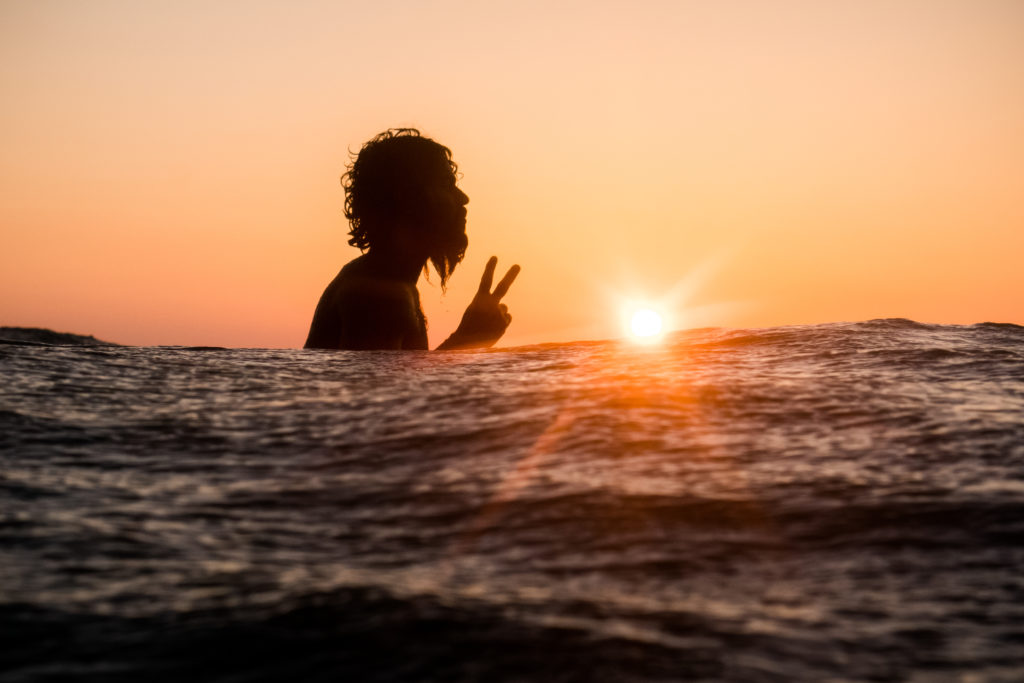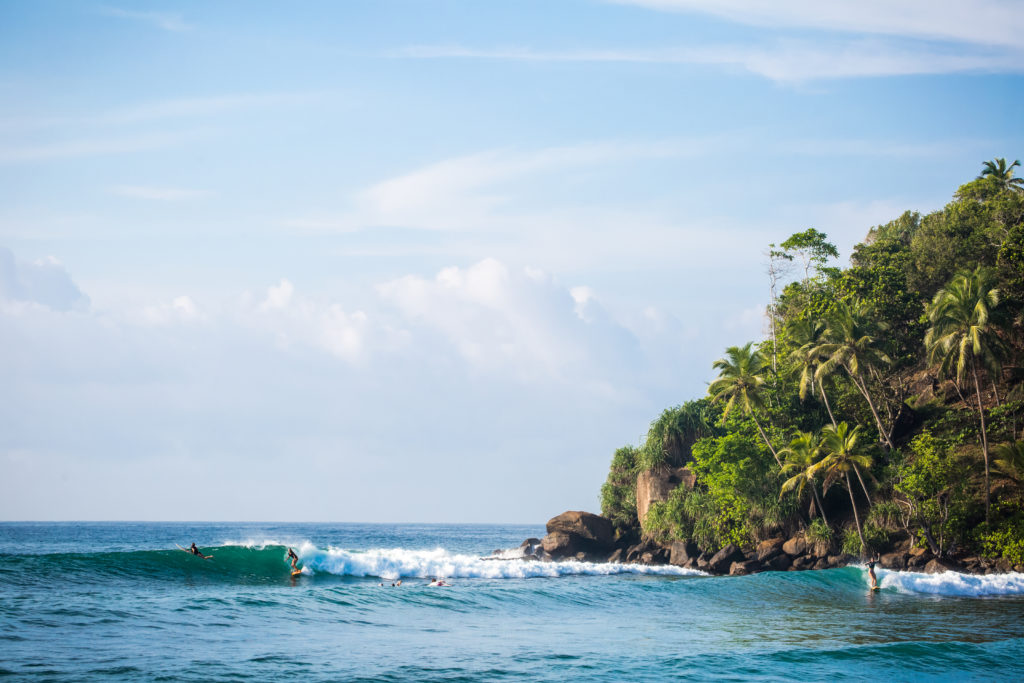Sri Lanka is a small teardrop shaped island that sits vulnerably in the Indian Ocean just below India. This means that the endges of the same swells which hit Indo, tickle the W, SW, S, SE, E and E Coasts of Sri Lanka.
The result? Consistent, welcomed, finely groomed swell, with a bit less punch.
So what are the waves like? How do you get there? What’s the food like? Where should you stay? Well here’s all you need to know.
Travel
Coming from the UK the best way to get to Sri Lanka is on a direct flight from London Heathrow to Colombo Bandaranaike with Sri Lankan Airlines. We aren’t in partnership with them or anything, they genuinely provide a great service, serving decent in-flight food, ample beers and are the only direct option from the UK. They also allow a generous baggage allowance of 30kg with no restrictions on the number of boards you can take.
When you arrive into Colombo, you can jump on a bus from the airport to the train station (around £1) then take the train down to your intended destination (less than £2). It’s a beautiful journey but a bit of a faff with a board.
If you are carrying boards then you should just get an air-conditioned taxi from the transfer desk at arrivals, as they are government approved with a fixed rate. This would take you to our Surf House in Ahangama in about 2 hours straight down the new highway and costs around £50 .
When you get to your intended location, dish out your international driving licence and hire a moped. The are cheap and a great way to get to the different surf spots, cost around £4 per day and petrol costs around 90p a litre. You won’t find bikes with racks attached to them here, so put your board in a bag and sling it over your shoulder, or sit on it. Always have your international driving licence on you as the police are becoming increasingly eager to make a quick buck in fines from tourists.
Seasons
Like all equatorial countries, Sri Lanka has two seasons; the monsoon season and the dry season. But Sri Lanka uniquely experiences two monsoon and two dry seasons throughout the year. The monsoon season brings with it wild, relatively un-surfable waves, whilst the dry season is sunny all day with clean swell rolling in, complimented by light winds until the midday trade winds pick up. This might sound a bit gnarly and confusing but it isn’t and it actually means it is sunny with good surf somewhere on the island all year round.
To put it simply, UK Winter (say October – April) is the West Coast’s Dry Season (the time to go) and the UK Summer (April – October) is the East Coast’s Dry Season. So if you’ve got holiday to take over Summer you’ll head to Arugam Bay. If you’re trying to escape the January Blues you’ll come and see us in Ahangama.

Credit @surf_srilanka
Surfing
So the important question is, what are the waves like? Well to summarise, it’s never flat, always fun and rarely scary. It’s a mellow version of Indonesia, with an equal balance of beach and reef breaks. This makes it the perfect destination for those learning to surf, beginner-intermediate surfers wanting an introduction to surfing that’s not-so-scary, part-time surfers and your average joe shredder.
That being said, Sri Lanka isn’t soft and has been on the map of travelling surfers since the 70’s, there are slabs, points and good a-frame reef break setups. I’m hardly giving away any secrets here, but here are a few of the places to check out.
Hikkaduwa: Hikkaduwa is broken up into the reef, which has a left and a right and the beach. The beach break is my personal favourite as it has punchy peaks up and down it with less people surfing as they are normally on the reef. Most people see it as a close-out but what I see is a very smashable end section. It’s also a good choice for beginners on whitewater. The reef break is the crowd-drawer which is an A-frame where the big ones break off of a predictable boil. The lefts are long and have a good lip to them and the rights can barrel. High tide is a bit weird as it gets back-washy. We take riders here for a day trip and sometimes end up overstaying our welcome as the nightlife is as appealing as the waves. If there’s enough juice in the waves for former European champ Grishka Roberts, then you’ll have fun.
Galle: I’ve never seen anyone surf here, but, I have seen mechanically perfect waves peel into the little bay beyond the old Dutch fortress countless times without a surfer in sight. There is a beach that is regularly surfed called Dewata, which is sheltered making it a great off season choice. It’s starting to get popular around there now with ex-pats who live year round and there are a few nice local places for food on the beach. It is polluted via the local fishermen and their off-cuts though.
Unawatuna: Again I’ve never surfed here but you can get a lobster, fries and a cold beer from one of the restaurants on the beach for £10. The waves have never looked that appealing to me but this guy seems to shred them.
Ahangama: This is the spot. A true local town, bursting with energy, delicious food, colourful markets, home to a dozen great waves and a right in the centre of the tourism boom. Im not even going to name the spots, some don’t even have names but there are plenty of waves. I was surfing a full on Indo style right hand barrel at the end of last season, whilst our guests where just down the roads taking off on peelers half the size. You’ll have to join us to find out for yourself.
Midigama: Midigama has been a popular area for a few years now, with a growing number of distractions including a surf shop that turns into a full all night Euro-rave on a Wednesday, and a couple of other places following suite. It has four good reef breaks all within walking distance of each other.
- The first is Lazy Rights, a very weak, long wave that breaks over a deep reef. This is perfect for beginners getting their first reef break experience or long boarders.
- Next up is Lazy Lefts. As the name suggests it’s a slow left-hander. It’s not great on a shortboard unless you’re a goofy footer and can stay close to the pocket like Shaggy here, but it’s great fun on a mini mal or longboard. You can get easily half a dozen cutbacks on one wave.
- Rams Right is a beautiful mini slab that offers a lovely barrel, followed by a nice shoulder to get a turn on. There’s also a left off the same wave, which isn’t as popular but still fun. The right is shallow and quite scary. We usually take riders here when the wind starts to go onshore (around 11 am) as by then, the early morning crowd have usually disappeared.
- Plantations and Coconuts: Again, these waves are just down the road and favoured by those looking for something in between Rams and Lazy’s. Both are fun and a great intro to reef-break surfing.
Weligama: We occasionally hold surf lessons here as it’s one of the best waves to teach on, the beach is massive and it’s really consistent. It still has it’s day and has helped create one of the best surfers in the island, Lucky. There are also waves off the island which work in stormy conditions and a just about paddle-able outer reef that conveniently does its thing when the wind goes onshore everywhere else.
Mirissa: This is 20mins in a tuk-tuk South of the our place. It’s a very popular tourist destination for non-surfers who flock to its pristine beaches and relaxing beach bar vibe. There is, however, a fun right-hand point break that breaks over shallow reefs full of urchins.

Classic Mirissa. Credit @surf_srilanka
Arugam Bay: This is the place that put Sri Lanka on the surfing map. Arugam Bay is on the east coast of the island and is made up of several right hand points that only work from April to November. There are some of the longest right hand points in the world that are mechanical. Again they are rarely scary big, and never flat (in season), imagine a shoulder high Jeffreys Bay. Like everywhere, the locals have it dialled.
That’s not completely it. In between Mirissa and Arugam Bay you have Matara and the South East which is a totally different ball game, home to loads of secret spots. Many are so secret that I wouldn’t know where to start and you would actually need a boat to get to them
So in summary, the waves in Sri Lanka are refreshingly consistent and rarely flat, very similar to Cornwall. The wind blows onshore from 12 – 5 pm every day, but we’re used to unfavourable wind conditions, most UK-based surfers will welcome these warm onshores.
Think more like Tropical Cornwall than pumping Bali. Rams feels like a balmy Porthleven, Lazy Lefts reminds me of Crantock river mouth, Hikkaduwa beach resembles mid-tide Croyde and the unnamed jewel of the crown is just like epic North Fistral.
Board-wise I always surf something with a bit of float, my 5’6 twinnie from Clayton goes well. This is 33 litres and I normally ride my 28-29 litre shortboard when the suckier waves like Rams and Madiha are on.
Eating and Drinking
Like everything else in Sri Lanka, food costs hardly anything. I’ve got a healthy appetite yet have had plenty of lunches for £1 which would consist of a couple of rotis, a few lentil biscuits and a milo. If you’re properly hungry, local rice and curry costs around £2. I’ve done a whole article on the food in Sri Lanka- it’s that damn good.
Oh and fresh coconuts cost 60RS (25p). TWENTY FIVE P.
Where to stay
A room on the beach can cost £5 which will be next door to a £300 a night place, there’s something for everyone. If you’re going super cheap think Leonardo Di Caprio in The Beach. You get what you pay for. If you’re not booking something beforehand, then you should just turn up and take a good look around.
If you’re heading down the coast to Ahangama / Midigama, demand actually outweighs supply. You’re going to want to book something for a week at least. Obviously we have a great setup, a stones throw from an epic wave with unparalleled surf coaching services headed by the legend Nikita Robb and decent food. If you’re heading East, there are plenty of rooms, but the guys at Safa Surf Camp have a great setup.
If you’re considering heading to Sri Lanka and want to ask some questions, feel free to fire away in the comments below, or drop me an email directly.